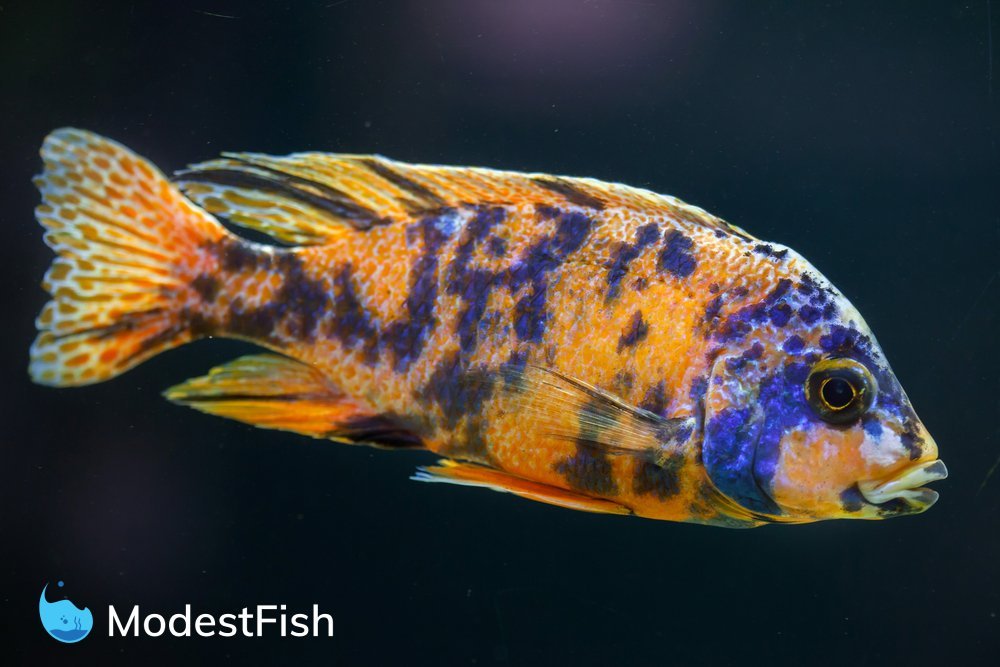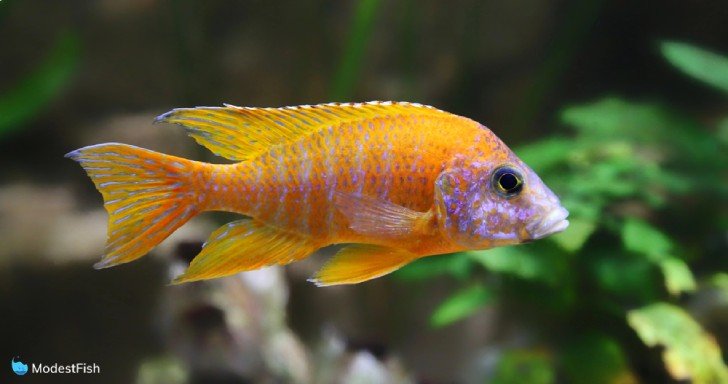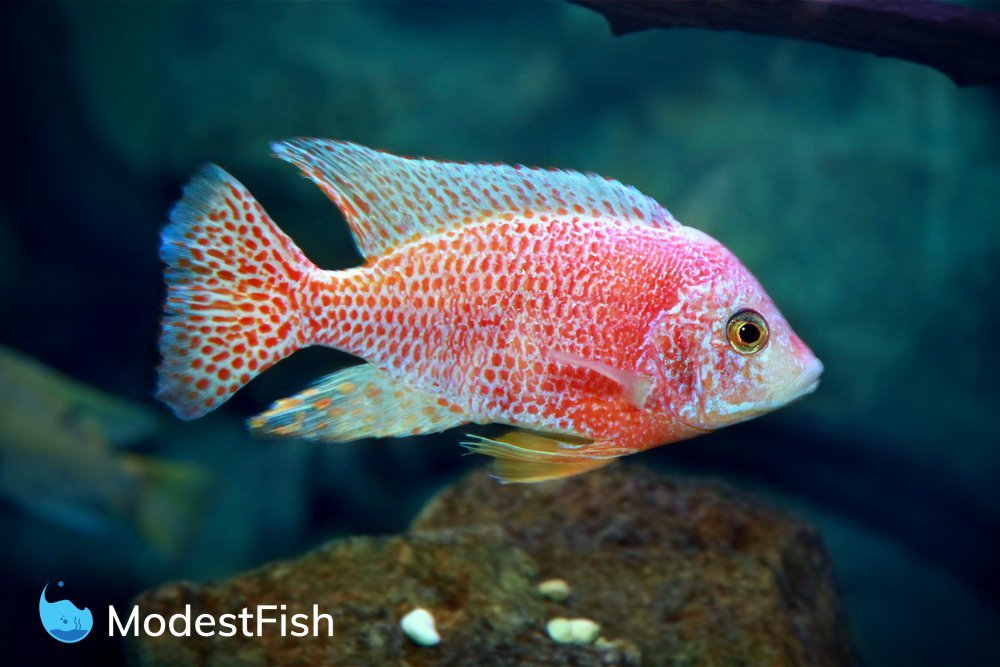Colorful, active, interesting, a peacock cichlid will rival any saltwater fish for beauty and enjoyment.
An incredibly rewarding fish (especially if you fancy your hand at breeding), in this guide, I’ll teach you everything you need to know to care for peacock cichlids.
Peacock Cichlid Care Guide Quick Overview:
- Min. Tank size: 55 gallons (208 liters)
- Temperature: 75°-82°F (24°-28°C)
- Care level: medium
- Diet: omnivore
- Behavior: extremely active mid to bottom dwelling fish
- How many can be kept together: as many as the tank can support. If you keep males and females together, it’s best to keep 2 females for every 1 male. Or you can have an all male tank.
- Size: 4-6 inches (10-15 centimeters)
- Genus: Aulonocara
Peacock Cichlids in the Wild
There are dozens of species of fish known as “peacock cichlids,” they are the only members of the genus Aulonocara.
They are native to Lake Malawi, the southernmost of Africa’s Rift Valley lakes. Lake Malawi has extremely hard water, meaning there are lots of minerals dissolved in the water, and a high pH of around 8.5.
They live in the shallows along the shores of the lake (some parts of the lake are over 2,300 feet deep!)

Their natural habitat is extremely rocky, with lots of little nooks and crannies to hide in.
Male peacocks stake out a small territory and try to impress females so that they’ll lay eggs for him to fertilize.
And there’s essentially no plant growth in their habitat. Anything that did try to grow would be devoured by thousands of hungry fish!
Peacock Cichlids Temperament
This group of fish are extremely popular in the aquarium hobby due to their vibrant colors, constant activity and mostly peaceful nature.
Compared to many species of cichlids, some of which are pretty much homicidal maniacs, peacocks are extremely laid back.
If you’re going to keep males and females together, it’s best to keep a ratio of at least 2 females for every 1 male.
Or you can keep an all male tank. With no girls to fight over, males of different species can coexist with very little aggression.
I especially like all male tanks since that means all of the fish are super colorful and you don’t have to worry about unintentional spawns.
Sexual Dimorphism In Peacock Cichlids
Peacock cichlids are highly sexually dimorphic, meaning that it’s easy to tell adult males and females apart because they look very different from each other.
Pro Tip: Male peacocks are the ones with the bright, flashy colors. Females are usually a drab brownish gray color.
So all the descriptions that I’ll list will refer to the males (sorry ladies).
Appearance & Body Type
All peacock cichlids share a similar body style. They’re a long-bodied fish, roughly torpedo shaped. They’re fairly thick bodied once they reach adulthood, not skinny or laterally compressed at all.
They have prominent dorsal fins with elongated rays that form points on the trailing edges. Their anal fins are shaped similarly, they are just a bit smaller than the dorsals.
They have fan shaped tails with rounded edges.
Peacock Cichlid Verities

Aulonocara Nyassae
This fish is sold under the common name emperor cichlid. Their base color is a royal blue color with metallic highlights. They have patches of red behind their gills and along their bellies.
Aulonacara jacobfreibergi
Known as the fairy cichlid or the butterfly peacock, this fish is absolutely stunning. Males are usually a bright red along their backs and lower fins. They have stripes of dark and electric blue along their bellies and heads. They also have a wide bright blue stripe that runs along their dorsal fins.
Aulonocara baenschi
This species is known as the Nkhomo-benga peacock. It is another bright yellow cichlid with a blue head. They stand out among a lot of other peacocks because they have an unusually long nose.
Aulonocara stuartgranti
Known as the Flavescent peacock, there are many different color morphs in this species. Some are yellow with blue heads, others are the exact opposite, and still others are somewhere in between.
Aulonocara baenschi
Known as the yellow regal peacock, this species is an intense yellow color. The bottom half of their heads are a dark black and they have a dusting of black and blue on their body scales.
Aulonocara Red Ruby
This is a man made variant. Males are an incredibly vivid red color with lighter stripes running vertically along their sides. They also have blue heads as well as random patterns of pinkish stripes on their dorsal fins and tails.
Aulonocara maylandi
Known by the common name sulphurhead peacock, these fish are a metallic blue color with a stripe of yellow that starts on their heads and runs along the top edge of their dorsal fins.
Aulonocara Maulana
Males are a bright metallic blue with a band of yellow that wraps around their bodies behind their gills.
Aulonocara Multicolor
This species has an orange color as it’s base and then has random spots of blue, red, yellow and/or black. They really are a spectacular looking fish.
OB Peacocks
OB peacocks are man-made hybrids, not a naturally occurring species. OB stands for “orange blotch.” Breeders mixed together different fish in a kind of haphazard way, just trying to get colorful and interesting fish. There is a huge variety of OB peacocks, when it comes to color, you never know what you’re going to get.
Tank Size For Peacock Ciclid
Peacock cichlids aren’t huge fish, males are usually around 6 inches (15 centimeters) long and females around 4 inches (10 centimeters), but they are extremely active fish that need a lot of swimming room.
I would recommend that you keep them in at least a 55 gallon (208 liter) tank. If you’d like to keep a colony of 10 or so, you’d do best to keep them in something like a 100 gallon (379 liter).
Peacock Cichlid Tank Requirements & Habitat

Heater
You will need a heater if you intend to keep peacock cichlids. Lake Malawi is quite warm year round.
You should keep your tank at temperatures of 75°-82°F (24°-28°C) to ensure your peacocks are happy and healthy.
Filtration
Filtration is an extremely important part of your aquarium set up, probably the most important part.
Related: Best Canister Filter For 55 Gallon Aquarium
The Aquarium Nitrogen Cycle
Some people think that the only real purpose of an aquarium filter is to circulate the water.
Don’t get me wrong, that’s an important part of its purpose, but it’s not the real reason that you have to use an aquarium filter.
Fish constantly put off wastes into the water, both urine and feces. Those wastes collect at the bottom of the tank and start to rot.
As the wastes break down, they start to produce ammonia (NH3). This is bad news because ammonia is highly toxic.
If one drop of ammonia is dissolved in one million drops of water, it’s so toxic that it can stress and kill fish.
Yep, it’s that bad.
Without some way to filter wastes out of the water column, our tanks would eventually become toxic wastelands once enough ammonia built up.
Lucky for us, there are beneficial bacteria that live in our filters. They eat ammonia and turn it into nitrite (NO2 -1). Nitrite is also very toxic, but the bacteria almost instantly convert it into nitrate (NO3-).
Nitrate is much less toxic and can be allowed to build up in the tank in between water changes.
This whole process, the transformation of ammonia to nitrate, is known as the Aquarium Nitrogen Cycle and is one of the most important things for aquarists to understand.
Pro Tip: See here for a more detailed explanation of the Nitrogen Cycle.
As you can see, filters are a really important piece of equipment. It’s critical that you get one that is large enough to keep up the waste your fish produce. And the more fish you have, the more filtration you need.
Peacock cichlids are fairly big fish that are extremely active. That means they eat a lot, and poop a lot.
I would recommend that you add a canister filter to your tank, like a Fluval 407, so that you have enough biomedia to keep up with all that waste.
Substrate
I really recommend that you use aragonite sand in a peacock cichlid tank.
Aragonite sand is made of pure calcium carbonate (CaCO3). This will slowly leach minerals into the water that will help mimic the peacock’s natural habitat.
Also, African cichlids love to dig and move mounds of sand around. Aragonite sands are perfect for this.
They can move this substrate around like a kid in a sandbox.
Lighting
Peacock cichlids don’t have any sort of lighting requirement. Just go with whatever lighting you think will look best in the tank.
LED lighting is often the best and most cost-effective aquarium lighting
Plants and Decor
The parts of Lake Malawi where peacocks live has a sandy bottom and lots of small boulders and rubble.
If at all possible, it’s best to replicate this in the aquarium. Having lots of rocks, driftwood and other decor that creates a large variety of hiding places and caves is optimal.
This will give the fish lots of options for setting up a territory in the tank.
Diet
Peacocks are omnivorous fish that will benefit from a varied diet.
I’d recommend going with a well-balanced cichlid pellet as their main staple diet, something like Omega One Super Color Cichlid Pellets.
Then you can add on other foods like frozen brine shrimp and bloodworms, and some occasional sinking wafers or Fluval Bug Bites.
Water Parameters
Here are the preferred water parameters aquarists should follow for Peacock Cichlids to keep them happy.
- Temperature 75°-82°F (24°-28°C)
- pH stable between 7.5 – 8.5
- Hardness 4-6dH
Breeding Peacock Cichlids
Peacock cichlids will readily breed in an aquarium environment.
Unless you have a huge tank, it’s best to place a breeding pair in their own tank. Males can become quite ferocious when they are spawning and rearing young.
Pro Tip: To get the adults into breeding condition, offer protein rich foods like bloodworms and brine shrimp.
The male peacock will set up a territory around a cave or group of rocks. The female will lay eggs inside the territory and the male will swoop in to fertilize them.
Peacocks are maternal mouth brooders, meaning, the female will carefully scoop up the fertilized eggs in her mouth and hold them there until they hatch.
She may keep tending to the fry for a day or two after they have hatched, but may just as well leave them to fend for themselves.
It’s best to remove the parents from the tank once the fry have hatched.
Peacock Cichlid Tank Mates
- Other peacock cichlids – if you keep a mixed tank, keep 1 male to every 2 females, or keep an all male tank with a mix of species
- Plecos
- Botia loaches
- Peaceful Haplochromis cichlids
- Synodontis catfish
- African red eye tetra
- Red tail shark
- Rainbow shark
Are Peacock Cichlids Right for You?
The biggest deciding factor in whether or not these peacock cichlids are right for you is tank size. These fish absolutely need to be placed in at least a 55 gallon, but bigger is always better.
They need lots of room to swim and several different options for caves and rock work so they can set up a territory.
Peacock cichlids do dig and tear up plants. So, if your dream is to have lots of lush live plants in your tank, sorry, this is not the species for you.
I also think they’re a very rewarding species if you want to dabble in fish breeding. Just make sure that you have an outlet to rehome fry.
If you’ve got the room, I highly recommend peacock cichlids. They are so colorful and active that they rival saltwater fish for beauty.
I hope that you find all of this information helpful.
I wish you and your fish the very best!

Thanks so much for the information. I’ve just bought a couple of cichlids and am very grateful for it. Have been keeping fish for years, also tilapias, but I’m new on the field of cichlids.
Fantastic information I’m currently cycling a 55 gallon tank ready for my peacock .